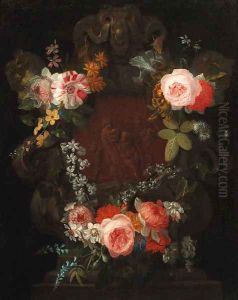Nicholas Van Verendael Paintings
Nicholas Van Verendael was a Flemish painter known for his exquisite still-life and floral paintings, born in 1640 in Antwerp, Belgium. He was part of the vibrant artistic milieu of the 17th century in the Southern Netherlands, which was a period marked by the flourishing of Baroque art influenced by the likes of Peter Paul Rubens. Van Verendael was deeply embedded in this artistic environment, which played a significant role in the development of his style and subjects.
His father, Lucas van Verendael, was also a painter, though not much is known about his work, suggesting that Nicholas may have received his initial training within his family. However, Nicholas's talent soon surpassed the confines of familial instruction, leading him to become a master in the Antwerp Guild of Saint Luke by 1664. This guild was a cornerstone of artistic life in the city, offering a network of artists, patrons, and opportunities for commissions.
Van Verendael specialized in still lifes, particularly flower pieces and garland paintings. His works are characterized by their meticulous attention to detail, vibrant colors, and the ability to convey the texture and delicacy of each flower. He often painted on copper, a medium that enhanced the luminosity and longevity of his work. His compositions were not just celebrations of natural beauty but also carried symbolic meanings, such as the brevity of life and the transience of beauty, which were common themes in Baroque art.
Despite his talent, Nicholas Van Verendael was not as well-known as some of his contemporaries during his lifetime. However, his works were collected by connoisseurs and have since gained recognition for their contribution to the Flemish still-life genre. His paintings can be found in several major museums, showcasing his skill in capturing the ephemeral beauty of flowers.
Nicholas Van Verendael's life was relatively short, as he died in 1691 in Antwerp. His legacy, though, has persisted, with his works serving as a testament to the skill and aesthetic sensibilities of Flemish artists in the Baroque period. Through his detailed and vibrant floral compositions, Van Verendael has secured his place in the annals of art history as a significant figure in the development of still-life painting in Europe.
